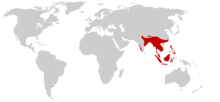
Back ناشر ملك Arabic ملك الكوبرا ARZ ডাঁহী সাপ AS Adi kral kobrası AZ Каралеўская кобра BE Каралеўская кобра BE-X-OLD Кралска кобра Bulgarian শঙ্খচূড় Bengali/Bangla Cobra reial Catalan Ophiophagus hannah CEB
| King cobra | |
|---|---|

| |
| Scientific classification | |
| Domain: | Eukaryota |
| Kingdom: | Animalia |
| Phylum: | Chordata |
| Class: | Reptilia |
| Order: | Squamata |
| Suborder: | Serpentes |
| Family: | Elapidae |
| Subfamily: | Elapinae |
| Genus: | Ophiophagus Günther, 1864 |
| Species: | O. hannah
|
| Binomial name | |
| Ophiophagus hannah Cantor, 1836
| |

| |
Distribution of the king cobra
| |
| Synonyms | |
|
Genus-level:
| |


The king cobra (Ophiophagus hannah) is in the Elapidae family of snakes. It is the longest venomous snake in the world. An adult king cobra can grow up to 18 feet (5.5 m), though most are less than 12 ft (3.7 m).[2][3] It is endemic to Asia.
King cobras are the longest of all venomous snakes. As they face a variety of threats stemming from human activities, these snakes are vulnerable to extinction.
The king cobra lives throughout India and in some parts of the south and the east of Asia. It is known around the world for its dangerous venom. It mostly avoids humans.[4] The King cobra lives up to 20 years.[5]
The king cobra lives in thick forests,[3][6] and likes areas dotted with lakes and streams.
It eats mostly other snakes but sometimes lizards and rodents.[7][8] After a large meal it may live months before eating again.[3]
The Indian grey mongoose is one of the few predators of the king cobra but may not attack them much.[9]
- ↑ Stuart, B.; Wogan, G.; Grismer, L.; Auliya, M.; Inger, R. F.; Lilley, R.; Chan-Ard, T.; Thy, N.; Nguyen, T. Q.; Srinivasulu, C.; Jelić, D. (2012). "Ophiophagus hannah". The IUCN Red List of Threatened Species. 2012. IUCN: e.T177540A1491874. doi:10.2305/IUCN.UK.2012-1.RLTS.T177540A1491874.en.
- ↑ "Cobra". Encyclopædia Britannica. Retrieved 2010-10-10.
- ↑ 3.0 3.1 3.2 Mehrtens, John (1987). Living snakes of the world. New York: Sterling. ISBN 0-8069-6461-8.
- ↑ O'Shea, Mark (2011). Venomous snakes of the world. Princeton University Press. ISBN 978-0-691-15023-9.
- ↑ "National geographic- KING COBRA". 10 September 2010.
They are fiercely aggressive when cornered; average life span in the wild: 20 years
- ↑ Miller, Harry (1970). "The cobra, India's 'good snake'". National Geographic. 20: 393–409.
- ↑ Cite error: The named reference
SSwas used but no text was provided for refs named (see the help page). - ↑ Coborn, John (1991). The atlas of snakes of the world. TFH Publications. pp. 30, 452. ISBN 978-0-86622-749-0.
- ↑ Mondadori, Arnoldo 1988 (ed.). Great book of the animal kingdom. New York: Arch Cape Press. p. 301.
{{cite book}}: CS1 maint: numeric names: editors list (link)
